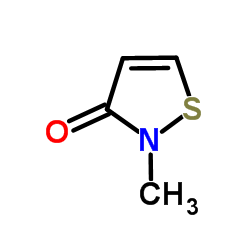2-Methyl-4-Isothiazolin-3-one

2-Methyl-4-Isothiazolin-3-one structure
|
Common Name | 2-Methyl-4-Isothiazolin-3-one | ||
|---|---|---|---|---|
| CAS Number | 2682-20-4 | Molecular Weight | 115.154 | |
| Density | 1.3±0.1 g/cm3 | Boiling Point | 182.8±23.0 °C at 760 mmHg | |
| Molecular Formula | C4H5NOS | Melting Point | 254-256 °C(lit.) | |
| MSDS | Chinese USA | Flash Point | 64.3±22.6 °C | |
| Symbol |



GHS05, GHS06, GHS09 |
Signal Word | Danger | |
|
Methylisothiazolinone contact allergy and dose-response relationships.
Contact Dermatitis 64(6) , 330-6, (2011) Methylisothiazolinone (MI) used alone is a new preservative causing a high prevalence of contact allergy. The eliciting threshold of MI is unknown. The combination of MI and phenoxyethanol enhances the antimicrobial efficacy of MI.The eliciting doses of MI co... |
|
|
Follow-up of the monitored levels of preservative sensitivity in Europe: overview of the years 2001-2008.
Contact Dermatitis 67(5) , 312-4, (2012)
|
|
|
Occupational contact dermatitis in painters: an analysis of patch test data from the Danish Contact Dermatitis Group.
Contact Dermatitis 67(5) , 293-7, (2012) Painters are among the occupational groups that most commonly experience occupational contact dermatitis, but few investigations exist concerning this occupation.To characterize painters with contact dermatitis and identify the most common allergens associate... |
|
|
Determination of preservatives in cosmetics, cleaning agents and pharmaceuticals using fast liquid chromatography.
J. Chromatogr. Sci. 52(1) , 88-94, (2013) This paper reports the development of a method for simultaneously determining five preservatives in cosmetics, cleaning agents and pharmaceuticals by fast liquid chromatography. Methylisothiazolinone, methylchloroisothiazolinone, benzyl alcohol, sodium benzoa... |
|
|
Effects of 5-chloro-2-methyl-4-isothiazolin-3-one and other candidate biodiesel biocides on rat alveolar macrophages and NR8383 cells.
Arch. Toxicol. 85(11) , 1419-27, (2011) Biocides are added to biodiesels to inhibit and remove microbial growth. The effects of 5-chloro-2-methyl-4-isothiazolin-3-one (CMIT), a candidate biodiesel biocide, were studied using freshly isolated rat alveolar macrophages (AM) and NR8383 cell line. CMIT ... |
|
|
Final report of the safety assessment of methylisothiazolinone.
Int. J. Toxicol. 29(4 Suppl) , 187S-213S, (2010) Methylisothiazolinone (MIT) is a heterocyclic organic compound used as a preservative in cosmetics and personal care products in concentrations up to 0.01%. MIT is a colorless, clear liquid with a mild odor that is completely soluble in water; mostly soluble ... |
|
|
Contact allergy to methylchoroisothiazolinone/methylisothiazolinone (MCI/MI): findings from a contact dermatitis unit.
Cutan. Ocul. Toxicol. 31(2) , 151-3, (2012) Several preservatives are currently allowed in cosmetic products in the EU. However, only a few of them are strongly represented on the market: formaldehyde, parabens, formaldehyde releasers and methylchoroisothiazolinone/methylisothiazolinone (MCI/MI). MCI/M... |
|
|
Abnormal visual processing and increased seizure susceptibility result from developmental exposure to the biocide methylisothiazolinone.
Neuroscience 205 , 194-204, (2012) Methylisothiazolinone (MIT) is a commonly used biocide known to be neurotoxic in vitro. Brief exposure of cortical neurons in culture to MIT results in increased neurodegeneration, whereas chronic exposure of developing neurons in culture to low concentration... |
|
|
Sensitization to methylisothiazolinone in a group of methylchloroisothiazolinone/methylisothiazolinone allergic patients.
Cutan. Ocul. Toxicol. 32(2) , 99-101, (2013) In the EU, Methylisothiazolinone (MI) was approved as a preservative in cosmetics and household products in 2005. Since then, several cases of MI contact allergy have been reported. We studied the prevalence of MI sensitization in patients allergic to Methylc... |
|
|
Allergic contact dermatitis caused by methylisothiazolinone from different sources, including 'mislabelled' household wet wipes.
Contact Dermatitis 69(5) , 311-2, (2013)
|